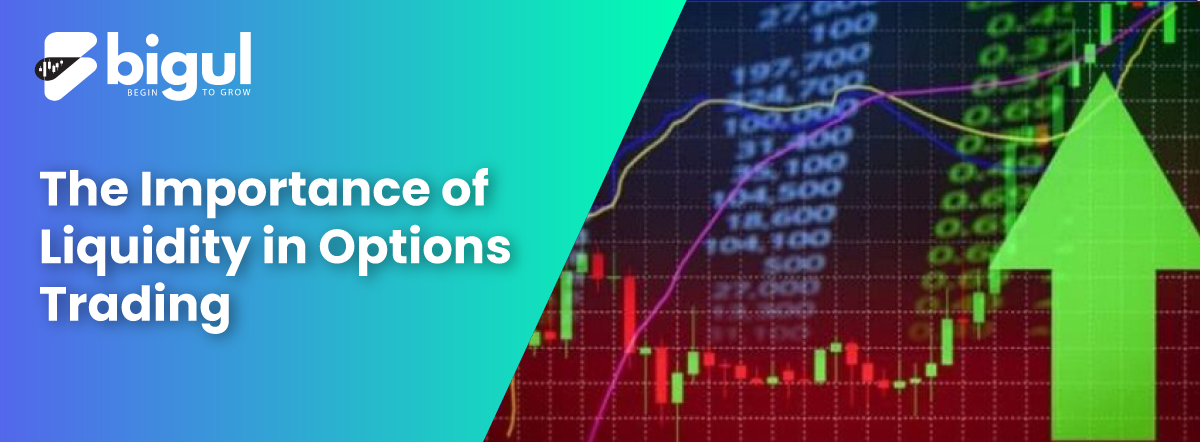The Importance of Liquidity in Options Trading
Options trading is a popular way to increase earnings and reduce portfolio risk. However, liquidity may dramatically affect options trading success.
Liquidity is the ease with which an asset may be purchased or sold in the market. Liquidity affects options trading prices and transaction costs. It helps investors make educated judgments and accomplish their options market investing goals.
In this post, we will discuss options trading liquidity, how to determine liquidity, tactics for trading liquid options, and potential hazards.
Also Read | What Is Put Writing? Meaning and Its Benefits
What is Liquidity?
Liquidity is the ease of buying or selling an asset in the market without impacting its price. Simply said, it’s the capacity to turn an asset into cash promptly and fairly. Liquid assets are easy to purchase and sell without price fluctuations. Financial market players buy and sell liquid assets with significant trading volume. In contrast, assets with low liquidity may have a low trading volume, making it challenging to purchase or sell the asset without influencing its price.
Factors Affecting Liquidity
Financial markets, particularly options trading, are impacted by several variables. These factors can affect the convenience and cost of purchasing and selling options contracts, market activity, and price changes. The following factors impact options trading liquidity:
➔ Trading Volume: Higher trading volume usually translates to higher liquidity.
➔ Market Depth: The number of buyers and sellers in a market can impact liquidity.
➔ Bid-Ask Spreads: Narrow bid-ask spreads are a sign of higher liquidity.
➔ Implied Volatility: High volatility can lead to lower liquidity.
➔ News and Events: Unexpected news or events can impact liquidity by affecting the number of buyers and sellers.
➔ Regulation: Tighter regulations can impact liquidity by reducing the number of market participants or increasing transaction costs.
➔ Market Structure: The way a market is designed or structured can impact liquidity. For example, electronic markets tend to be more liquid than floor-based markets.
Why Liquidity is Important in Options Trading
Liquidity is important in options trading for several reasons:
➔ Narrow bid-ask spreads: When options are liquid, bid-ask spreads narrow. This allows buyers and sellers to trade at prices closer together, lowering transaction costs and improving efficiency.
➔ Lower transaction costs: Liquidity also leads to lower transaction costs, which can be a significant factor for options traders who frequently enter and exit positions.
➔ Ease of execution: Liquid options are easier to buy and sell quickly, which can be important for traders who need to enter or exit positions promptly.
➔ Increased flexibility: Liquid options give traders more flexibility regarding strike prices and expiration dates. Traders can easily enter and exit positions in options close to or far from the current market price and choose from various expiration dates.
In contrast, trading in illiquid options can be more complex and costly. The bid-ask spreads are wider, making it tougher for dealers to acquire fair pricing. Illiquid options can also be tougher to sell or acquire, resulting in delayed execution times and greater transaction costs.
Overall, liquidity is crucial for traders when deciding which options to trade. By focusing on liquid options, traders can reduce costs and improve their trading efficiency.
How to Determine Liquidity in Options Trading
When it comes to determining liquidity in options trading, two important factors to consider are the daily volume and the open interest.
Daily Volume:
Daily volume refers to the total number of options contracts exchanged in a single day. Since there are more buyers and sellers, a higher daily volume suggests better liquidity. When there are more buyers and sellers, option contracts are cheaper.
Open Interest:
Open interest refers to the number of outstanding option contracts that have not been closed or exercised. A higher open interest also indicates greater liquidity because more active contracts are available for trading. Open interest can show traders how many other participants are interested in a particular option contract. To determine liquidity in options trading, consider the daily volume and open interest together.
A high daily volume and a high open interest are ideal because it suggests that the market for that option contract is both active and liquid. However, it’s important to note that high volume or open interest alone may not always indicate that a particular option contract is liquid.
Sometimes, a large open interest may be due to long-term investments or hedging positions rather than trading activity.
Strategies for Trading Liquid Options
Now that we have discussed the importance of liquidity in options trading, let’s take a closer look at some popular trading strategies for liquid options.
Here are some popular trading strategies for liquid options:
Buying and Selling Options: One approach to trading liquid options is buying and selling options, which involves different types of strategies such as calls and puts, spreads, straddles and strangles.
Calls and Puts
➔ Buying call options is a bullish strategy that allows traders to profit from an increase in the underlying asset’s price.
➔ Buying put options is a bearish strategy that allows traders to profit from a decrease in the underlying asset’s price.
➔ Selling a call-and-put option is a strategy that allows traders to collect premiums but comes with increased risk and the potential for significant losses.
Spreads
➔ Vertical spreads involve buying and selling options of the same type (calls or puts) with different strike prices, creating a range of profit potential.
➔ Horizontal spreads involve buying and selling options with the same strike price but different expiration dates.
➔ Diagonal spreads involve buying and selling options with different strike prices and expiration dates.
Straddles and Strangles
➔ Straddles involve buying a call-and-put option with the same strike price and expiration date, allowing traders to profit from significant price movement in either direction.
➔ Strangles involve buying a call and put option with different strike prices and expiration dates, allowing traders to profit from significant price movement in either direction but with less risk than straddles.
Hedging Strategies
When it comes to hedging in options trading, there are several strategies to consider, including covered calls, protective puts, straddles, and collars. Let’s explore these strategies in more detail.
Covered Calls
This strategy involves buying an underlying asset and selling a call option on that asset, providing downside protection and a steady stream of income.
Protective Puts
This strategy involves buying a put option to protect against a decline in the underlying asset’s price.
Collars
This strategy involves buying a put option to protect against downside risk and selling a call option to offset the cost of the put option, resulting in limited upside potential.
Conclusion
In conclusion, liquidity is a crucial factor to consider when trading options. It affects transaction costs, ease of execution, and flexibility. Traders should assess liquidity through open interest and volume, bid-ask spreads, implied volatility, and market makers.
Trading liquid options allows for advantages such as narrow bid-ask spreads, while illiquid options may have wider spreads and be more challenging to execute. Proper risk management is also crucial when trading options, and seeking professional advice is highly recommended.
Also Read | Navigating the World of Put Writing: Strategies, Benefits, and More





.jpg)





.jpg)
